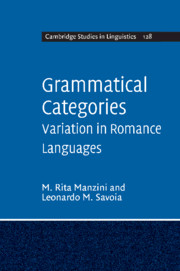Book contents
- Frontmatter
- Contents
- List of tables
- Acknowledgements
- Introduction: grammatical categories and the biolinguistic perspective
- 1 The structure and interpretation of (Romance) complementizers
- 2 Variation in Romance k-complementizer systems
- 3 Sentential negation: adverbs
- 4 Sentential negation: clitics
- 5 The middle-passive voice: evidence from Albanian
- 6 The auxiliary: have/be alternations in the perfect
- 7 The noun (phrase): agreement, case and definiteness in an Albanian variety
- 8 (Definite) denotation and case in Romance: history and variation
- Notes
- References
- Index
4 - Sentential negation: clitics
Published online by Cambridge University Press: 11 April 2011
- Frontmatter
- Contents
- List of tables
- Acknowledgements
- Introduction: grammatical categories and the biolinguistic perspective
- 1 The structure and interpretation of (Romance) complementizers
- 2 Variation in Romance k-complementizer systems
- 3 Sentential negation: adverbs
- 4 Sentential negation: clitics
- 5 The middle-passive voice: evidence from Albanian
- 6 The auxiliary: have/be alternations in the perfect
- 7 The noun (phrase): agreement, case and definiteness in an Albanian variety
- 8 (Definite) denotation and case in Romance: history and variation
- Notes
- References
- Index
Summary
Many Romance languages have a negative clitic which stands alone (for instance standard Italian) or is doubled by a negative clitic (for instance French). Since Pollock (1989) these have been modelled by a NegP projection in which the negative clitic and the negative adverb occupy the head and Spec position respectively. According to Zanuttini (1997), who extends this model to Italian dialectal variation, languages which require a sentential negation adverb generate it in one of the lower Neg positions; if a clitic combines with the adverb, it is generated in the head of the relevant Neg position and moves to the inflectional domain by cliticization. By contrast, negative clitics in languages like Italian which do not require a sentential negation adverb are hosted by a Neg position generated above I, Neg1.
In other words, for Zanuttini (1997) preverbal clitic negations are associated with two different structures, according to whether they stand alone or combine with a negative adverb. Moreover, she detects a correlation between these structures and the ordering of the negative clitic with respect to subject clitics in languages that have both of them. In her terms Neg1, hence the standalone negative clitic, will precede inflected subject clitics, though it may follow vocalic uninflected subject clitics. Counterexamples to this generalization are Tuscan varieties in which the standalone negative clitic precedes 1st/2nd person subject clitics but follows 3rd person ones (cf. Càsola in (7) below).
- Type
- Chapter
- Information
- Grammatical CategoriesVariation in Romance Languages, pp. 128 - 158Publisher: Cambridge University PressPrint publication year: 2011



